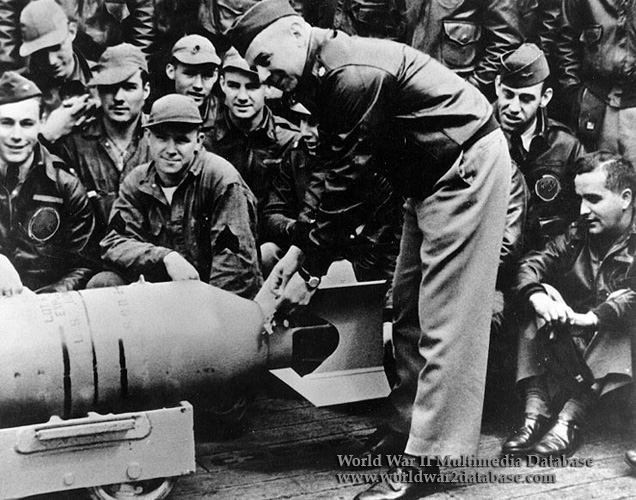| Lieutenant Colonel James H. Doolittle, USAAF (front), leader of the raiding force, wires a Japanese medal to a 500-pound (227-kilogram) bomb, during ceremonies on the flight deck of USS Hornet (CV-8), shortly before his force of sixteen B-25B bombers took off for Japan. The planes were launched on 18 April 1942. The wartime censor has obscurred unit patches of the Air Force flight crew members in the background. The raid had its roots in a chance observation that it was possible to launch Army twin-engined bombers from an aircraft carrier, making feasible an early air attack on Japan. Appraised of the idea in January 1942, U.S. Fleet commander Admiral Ernest J. King and Air Forces leader General Henry H. Arnold greeted it with enthusiasm. Arnold assigned the technically-astute Doolittle to organize and lead a suitable air group. The modern, but relatively well-tested B-25B “Mitchell“ medium bomber was selected as the delivery vehicle and tests showed that it could fly off a carrier with a useful bomb load and enough fuel to hit Japan and continue on to airfields in China. Doolittle recruited his volunteers from the 17th Bomber Group and the 89th Reconnaissance Squadron. They began their training at Eglin Air Force Base in Florida. So secret was the operation that her Commanding Officer, Captain Marc A. Mitscher, had no idea of his ship‘s upcoming employment until shortly before sixteen B-25s were loaded on her flight deck. On 2 April 1942 Hornet put to sea and headed west across the vast Pacific. Joined in mid-ocean on 13 April by Vice Admiral William F. Halsey‘s flagship Enterprise, which would provide air cover during the approach, Hornet steamed toward a planned 18 April afternoon launching point some 400 miles from Japan. However, before dawn on 18 April, enemy picket boats were encountered much further east than expected. These were evaded or sunk, but got off radio warnings, forcing the planes to take off around 8 AM, while still more than 600 miles out. Most of the sixteen B-25s, each with a five-man crew, attacked the Tokyo area, with a few hitting Nagoya. Damage to the intended military targets was modest, and none of the planes reached the Chinese airfields (though all but a few of their crewmen survived). However, the Japanese high command was deeply embarrassed. Three of the eight American airmen they had captured were executed. Spurred by Combined Fleet commander Admiral Isoroku Yamamoto, they also resolved to eliminate the risk of any more such raids by the early destruction of America‘s aircraft carriers, a decision that led them to disaster at the Battle of Midway a month and a half later. | |
| Image Filename | wwii1079.jpg |
| Image Size | 190.48 KB |
| Image Dimensions | 636 x 500 |
| Photographer | Unknown |
| Photographer Title | |
| Caption Author | Jason McDonald |
| Date Photographed | April 16, 1942 |
| Location | USS Hornet (CV-8) |
| City | USS Hornet (CV-8) |
| State or Province | Enroute to Japan |
| Country | Pacific Ocean |
| Archive | United States Naval Historical Center |
| Record Number | |
| Status | Caption ©2007, ©2024 MFA Productions LLC Image in the Public Domain |

Author of the World War II Multimedia Database

